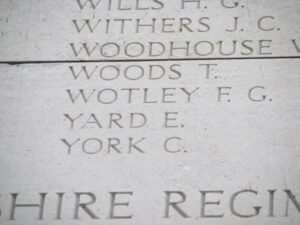Burry Port is a large town situated overlooking Carmarthen Bay, on the Burry Estuary. The men of the town who lost their lives in both world wars are commemorated on a war memorial which also contains the names of the fallen of the neighbouring town of Pembrey. For clarity, I have split the memorial up, to separate the two towns, so Pembrey has its own separate page. This web-page commemorates the men of Burry Port who fell during World War One.
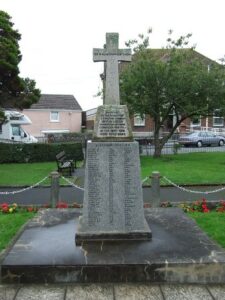
The Great War, 1914-1918
Hugo Robert Arthur, Private, 4745, Australian Infantry. Hugo was born at Burry Port, the son of Robert John Arthur and Emma Lucy Arthur (nee Hart). He had emigrated to Australia with his wife Gladys Blodwen Arthur early in 1914, and set up home at Kensington, NSW. Hugo enlisted at Adelaide on 1 January 1917 and joined the 13th Reinforcements of the 43rd Battalion, which embarked at Adelaide on 23 June 1917 aboard HMAT Borda bound for England. The Battalion was part of 11 Brigade, 3rd Australian Division, and Hugo joined them in France on 18 December 1917. The Division had just come through the Battles of Third Ypres, and had suffered heavy casualties there. Early in 1918 Hugo broke his ankle, and spent time at Edmonton Military Hospital recovering, therefore missing the terrible time of the German Spring Offensive on the Western Front throughout March and April 1918. On 21 July 1918 he rejoined his unit on the Somme, where they were preparing to launch a major offensive near Villers Brettoneux, astride the old Roman Road from Amiens to Péronne. Hugo was killed in action here, during the Battle of Amiens, on 11 August 1918, just days after the Australian Corps had won an impressive Battle at Villers Brettoneux, which proved to be the turning point of the war. He was 32 years old, and is buried at Heath Cemetery, Harbonnieres, France.
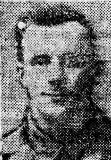
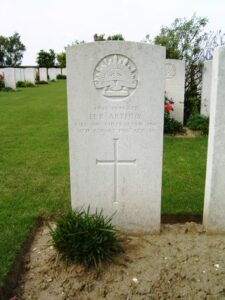
Henry Bannell, Corporal, 7006, Wiltshire Regiment. Henry was born at Salisbury, and resided at Pembrey prior to the war. He enlisted back at Salisbury into the 2nd Battalion, Wiltshire Regiment, which was attached to 21 Brigade, 7th Division. The Division was formed during September, 1914 and landed at Zeebrugge on 6 October 1914. The City was already falling however, and so the Division was moved to Ypres, where they became the first British Division to hold the city. They fought during the First Battle of Ypres, and helped stop the German advance through Belgium, and in March, 1915 fought at the Battle of Neuve Chapelle. During May they fought at the Battle of Aubers Ridge, and at Festubert, before taking part in the Battle of Loos in September. The Division took part in the initial assault north of the Vermelles-Hulluch road, facing the Quarries and a series of strongpoint’s. Suffering badly from British cloud gas, which was not moved sufficiently by the gentle breeze, and badly cut up by German machine gun fire and artillery, the Division nonetheless seized the Quarries and only failed to penetrate the third German line due to the relative weakness of the numbers of men that got through. In the summer of 1916, the Division were on the Somme, and took part in the Battle of Albert, where they captured Mametz, one of the few successes of 1 July 1916. They then fought at the Battle of Bazentin, where Henry was killed in action on 8 July 1916. He is buried at Bernafay Wood British Cemetery, Montauban, France.
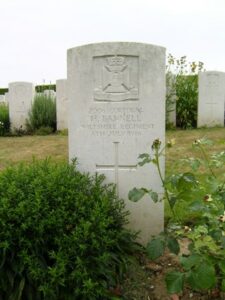
Richard Bevan, MM, Corporal, 45950, Welsh Regiment. Richard was born at Neath, the son of Richard and Mary Ann Bevan. He resided at Burry Port prior to the war, and enlisted at Llanelli into the 2nd Battalion, Welsh Regiment, which was attached to 3 Brigade, 1st Division. The Division had been one of the first to arrive in France, fighting at the Battle of Mons, and taking part in the retreat to the Marne, where the Germans were stopped. They then fought at the Aisne, and at Chivy, before being moved north to Ypres. Here they fought at the First Battle of Ypres, where they again stopped the German Offensive, before wintering in Flanders. The following year saw them in action again at the Battle of Aubers, before moving South to Loos, where they fought during the Battle of Loos, and the action at the Hohenzollern redoubt. Again they were required for a major offensive, moving south to the Somme, where they fought during the opening of the Somme Offensive at the Battle of Albert, then at Bazentin, Pozieres, Flers-Courcelette and Morval. They followed the German retreat to the Hindenburg Line in early 1917, and were then briefed for an operation on the Flanders Coast, and moved there during the summer of 1917. While training on the coast, the Battle of Third Ypres had stalled in the mire, and the Division were recalled to Ypres, where they fought at Passchendaele. After spending another winter in Flanders, they were near Estaires when the German Spring Offensive caught them, fighting through the Battles of Estaires, Hazebrouck, and Bethune before being moved south again to Arras, fighting at the Battle of Drocourt-Queant, and at the Battle of Épehy, after the tide had been turned in the favour of the Allies. The Division pushed on towards the St. Quentin Canal, where Richard was killed in action on 15 September 1918. He has no known grave, and so is commemorated on the Vis-En-Artois Memorial, France.
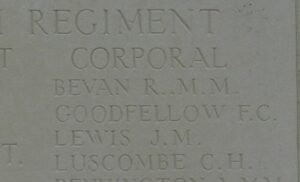
Sidney Bowen, Ordinary Seaman, J/71871, Royal Navy. Sidney was born on 26 September 1898, the son of Mary Bowen, of 99, Pencoed Road, Burry Port. He served with the Royal Navy aboard H.M.S. Contest. She was a K-Class Destroyer that served with the Grand Fleet. She was torpedoed by a German Submarine on 18 September 1917 in the North Sea, and sank with heavy loss of life. Sidney died aboard her in the sinking. He was 18 years old and is commemorated on the Plymouth Naval Memorial, Devon.
George Bradley, MID, Private, 306557, Royal Warwickshire Regiment. George was the son of Mr and Mrs George Bradley, of Lincoln. He resided at Derwyd Bungalow, Burry Port prior to the war, and enlisted at Pembrey on 10 December 1915 into the Royal Warwickshire Regiment. On 25 July 1916 he landed in France and was posted to the 1/8th Battalion, Royal Warwickshire Regiment, which was attached to 143 Brigade, 48th (South Midland) Division. The Division fought throughout the Somme offensive that year. In March 1917 they followed the German Retreat to the Hindenburg Line, and later in the year fought at Third Ypres, at the Battle of Langemarck, the Battle of the Polygon Wood, the Battle of Broodseinde and the Battle of Poelcapelle. The Division was ordered to Italy on 21 November 1917, where it remained for the duration of the war, taking part in actions on the Asiago Plateau- the Battle of Asiago and the Advance from Asiago, with the infantry of 143rd Brigade becoming the first British soldiers to enter the home territory of the Central Powers. George was killed in action here on 15 June 1918, during the Battle of The Piave River. He was 30 years old and is buried at Magnaboschi British Cemetery, Italy. George is not named on the Burry Port Memorial and was Mentioned in Despatches on 9 April 1917.
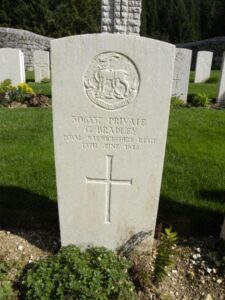
Alan Cuthbert Calvert, Sapper, 586, Royal Engineers. Alan was the son of Charles James and Elizabeth Calvert, of 1, Belgrave Villas, Bath. He worked as a surveyor at Burry Port prior to the war and enlisted at Llanelli into the Royal Engineers, and was posted to the 1/1st Welsh Field Company. The Company was attached to the 53rd (Welsh) Division, and landed at Cape Helles, Gallipoli, on 8 August 1915, and was immediately thrown into heavy fighting. Alan was killed in action during the Defence of Helles on 8 September 1915. He was 25 years old, and is buried at Green Hill Cemetery, Gallipoli. Alan is not named on the Burry Port Memorial, but is shown among the Burry Port men on the Carmarthen County War Memorial roll.
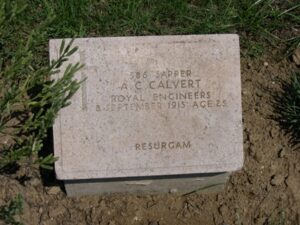
Walter Camp, Private, G/21235, Royal West Kent Regiment. Walter was the son of John and Dina Camp, of Pwll, and enlisted at Llanelli on 11 May 1916 into the Monmouth Regiment. He was posted to France on 23 September 1917, and joined the 10th Battalion, Royal West Kent Regiment, which was attached to 123 Brigade, 41st Division. The Division was selected as one of five British Divisions to be moved to Italy, as part of a reinforcement action taken by the Allies following a disastrous defeat of the Italian Army at Caporetto. The Company arrived at Mantua on 17 November 1917, where they held a part of the line on the River Piave, however, the crisis had passed and the Division was hurried back to the Western Front in early March 1918. They then faced the German Spring Offensive of 21 March 1918, and fought at the Battle of St Quentin, and retreated westwards, fighting at the First Battle of Bapaume. They also then fought at the First Battle of Arras, before being withdrawn, and sent north to Flanders where it held a sector near Ypres that was, for once, relatively quiet. Here they took part in the Advance in Flanders, and the Battle of Ypres 1918, before moving on to fight at the Battle of Courtrai, and the subsequent Action of Ooteghem. Walter was wounded during these final actions of the war, and was evacuated to the 2nd Australian Hospital at Wimereux, where he sadly died of wounds on 19 November 1918, aged 20. He is buried at Terlincthun British Cemetery, Wimille, France.
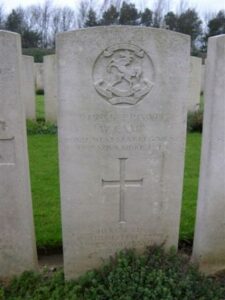
Cecil Richard Trevor Chard, Lance Sergeant, 8791, South Staffordshire Regiment. Cecil was the son of Harry and Kate Chard, of Burry Port. He married Bertha Govier in 1908 and the couple lived at Cardiff. Cecil enlisted at Walsall into the 1/5th Battalion, South Staffordshire Regiment. The Battalion was attached to 137 Brigade, 46th (North Midland) Division. It moved to France from 23 February 1915, and saw its first action at the Hohenzollern Redoubt near Loos. The Division suffered large numbers of casualties during the attack, which was its first large-scale action. Cecil was one of the many casualties here, killed in action on 13 October 1915, aged 31. He has no known grave, and so is commemorated on the Loos Memorial, France. Cecil is not commemorated locally.
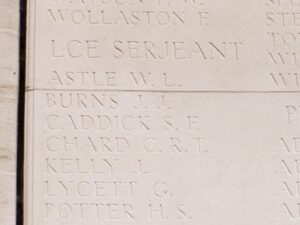
John Charles, Private, 5549, Royal Welsh Fusiliers. John was the son of John and Catherine Charles, of 11, Carroway Street, Burry Port. He enlisted on 18 August 1914 at Tonypandy into the 1st Battalion, Royal Welsh Fusiliers. They were attached to 22 Brigade, 7th Division, landed at Zeebrugge on 6 October 1914. The City was already falling however, and so the Division was moved to Ypres, where they became the first British Division to hold the city. John joined the battalion as a reinforcement on 23 November 1914, during the First Battle of Ypres, where the division helped stop the German advance through Belgium. After wintering in Flanders in March 1915 the division fought at the Battle of Neuve Chappelle. During May they fought at the Battle of Aubers Ridge, and at Festubert, where John was killed in action on 16 May 1915, aged 20. He has no known grave and so is commemorated on the Le Touret Memorial, Richebourg L’Avoue, France.
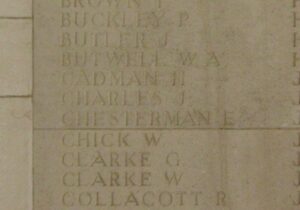
David Brynmor Chiles Evans, DSO, M.R.C.S., L.R.C.P., Lieutenant-Colonel, Royal Army Medical Corps. David was the son of David and Elizabeth Chiles Evans, of 2, Goring Villas, Burry Port. He had served in South Africa during the Anglo-Boer War as a surgeon with the Welsh Hospital, and after the war became a surgeon in the Swansea Workhouse before running his own thriving surgery in the town. When the Great War erupted, David re-enlisted into the army and became the Medical Officer of the 1st Battalion, West Yorkshire Regiment, which was attached to 18 Brigade, 6th Division. On 10 September 1914 the Division landed at St Nazaire and proceeded to the Western Front, and arrived in time to reinforce the hard-pressed BEF on the Aisne, before the whole army was moved north into Flanders. Here they took part in the Action of Hooge during June, 1915. David was the medical Officer that examined the detainee Private Harry Farr of the 1st West York’s early in 1916, after he had twice been treated for being ‘nervy’. Harry was subsequently executed for Cowardice, a sentence which has only in recent years been rescinded, and a full pardon given him. In 1916 the Division were on the Somme, and David was wounded here, at Ginchy, on 17 September 1916 but returned to duty. The following year saw the Division at Arras, where they fought at the Battle of Hill 70. David was killed during this time, on 23 April 1917, aged 40. He is buried in Bethune Town Cemetery, France.
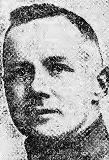
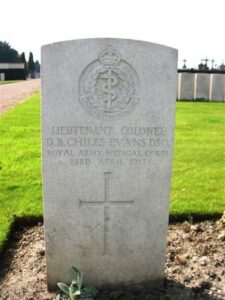
Ernest Newton Cole, Private, 14479, South Wales Borderers. Ernest was the son of George and Elizabeth Martha Cole, of 2, Tyle Leg, Garden Suburb, Burry Port. Ernest enlisted at Llanelli into the 5th Battalion, South Wales Borderers, attached to 58 Brigade, 19th (Western) Division. The Division crossed to France during July 1915, and moved to positions near Loos. The Division fought during the opening attack of the Battle of Loos, and then moved to the Somme, where they took part in the second wave of the attack on Ovillers-La Boiselle on 1 July 1916, capturing the village at heavy cost, and fought through the Somme Battles of Pozieres and the Ancre in 1916. They then moved North to Ypres, taking part in the Battle of Messines, and fought on the Menin Road and at Polygon Wood, before moving up to Broodseinde, Poelcapelle and Passchendaele Village itself. In 1918 they were caught up in the German Spring Offensive near St. Quentin, where they suffered terrible casualties, and fought at the Battle of Bapaume. They moved to Ypres, but were caught up in the German attack at Messines, where Ernest was killed in action on 11 April 1918, aged 29. He has no known grave, and so is commemorated on the Tyne Cot Memorial, Belgium.
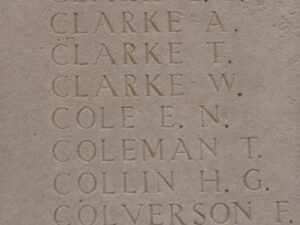
James Stanley Cole, Private, 282295, Lancashire Fusiliers. James was the son of Thomas and Edith Mary Cole, of Carne Mountain, Begelly, and resided at Burry Port prior to the war. He served with the 2nd/ 7th Battalion, Lancashire Fusiliers, attached to 197 Brigade, 66th Division. The Division concentrated on the Western Front by 16 March 1917 and moved to the Flanders Coast. At the end of September 1917 they moved to Ypres, and took part in the Battle of Poelcapelle. James was killed in action here on 18 November 1917. He was 27 years old, and is buried at Dochy Farm New British Cemetery, Belgium. James is not commemorated at Burry Port, but at Begelly.
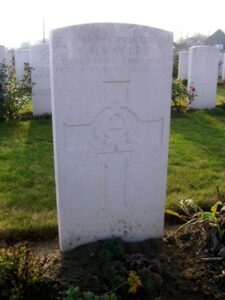
Victor James Cole, MSM, Acting Lance Corporal, WR/178798, Royal Engineers. Victor was the son of George and Elizabeth Cole, of Burry Port, and the Husband of Margaret Cole, of 5, Dolau Road, New Dock, Llanelli. He enlisted at Carmarthen into the Pembroke Yeomanry, and later transferred into the Railways Division, Royal Engineers. The RE Railway workers served on the Western Front throughout the whole of the war, often in close proximity to the front. Victor was awarded the Meritorious Service Medal at some time here, but was wounded in 1918 and came home for treatment. He sadly died of wounds at Bagphale Hospital, Nottingham on 27 September 1918, aged 28, and is buried at Llanelli (Box) Cemetery.

Reginald Lingard Collins, Private, 282352, Lancashire Fusiliers. Reginald was the son of Augustus Charles and Minnie Collins. By 1911 the family had moved to Lilybank, 57, Pencoed Road, Burry Port. Reginald had married Lilian Edwards at Llanelli in 1915. He enlisted at Trealaw into the 2/7th Battalion, Lancashire Fusiliers, which was a Territorial unit attached to 197 Brigade, 66th (2nd East Lancs.) Division. The Division concentrated on the Western Front by 16 March 1917 and moved to Flanders, and sadly Reginald was killed soon after, on 1 April 1917. He was 23 years old, and is buried at Gorre British and Indian Cemetery, France.
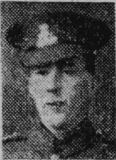
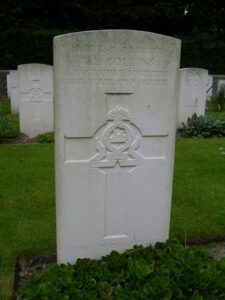
Frederick Daniel, Bombardier, 120565, Royal Field Artillery. Frederick was the stepson of Lewis Williams and the son of Emily A Williams, of 65, Stepney Road, Burry Port. He enlisted at Finsbury into the Royal Field Artillery, and moved to France attached to their 24th Battery, 38th Brigade, attached to the 6th Division. On 10 September 1914 the Division landed at St Nazaire and proceeded to the Western Front, and arrived in time to reinforce the hard-pressed BEF on the Aisne, before the whole army was moved north into Flanders. Here they took part in the Action of Hooge during June, 1915, and in 1916 moved to the Somme, where the Division fought at the Battle of Flers-Courcelette, the Battle of Morval and the Battle of Le Transloy. The following year saw them at Arras, where they fought at the Battle of Hill 70, which is where Frederick was killed, on 1 October 1917, aged 28. He is buried at Brandhoek New Military Cemetery No. 3, Belgium. Frederick is not commemorated locally.
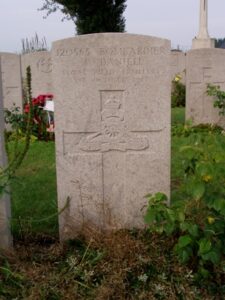
Ralph Picton Daniel, Captain, Royal Welsh Fusiliers. Ralph was the son of Philip and Naomi Daniel, of Bryn y Mor, Burry Port. He was commissioned on 6 March 1915 into the 17th Battalion, Royal Welsh Fusiliers, which was attached to 115 Brigade, 38th (Welsh) Division. The Division had landed in France during December 1915 and had spent their first winter in the trenches near Armentieres. In June they marched south to the Somme, where they famously captured Mametz Wood in July 1916. The Division suffered terrible casualties at Mametz, and were taken out of the line, and moved to Ypres to rebuild. Here they fought at Pilckem Ridge, and it was during the opening assault that Ralph was killed in action on 31 July 1917, aged 35. He is buried at Artillery Wood Cemetery, Belgium.
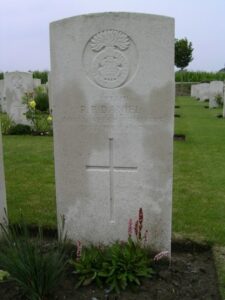
Albert Owen Davies, Signaller, Z/1094, Royal Naval Volunteer Reserve. Albert was born on 22 August 1882, the son of William and Jane Davies, of 3, New Street, Burry Port. He joined the staff of Llanelli Post Office in 1904. Albert enlisted into the Royal Naval Volunteer Reserve on 25 May 1915 and was initially posted to the Royal Naval Division before being posted to HMS Pembroke I. He was based at Woolwich when he was killed during an accident on 2 December 1917, aged 29. His remains were conveyed back home and he was buried with full military honours in Burry Port (Tabernacle) Baptist Chapelyard. The CWGC and his pension records state that he served aboard HMS Paladin, which was an M-Class destroyer, but his service and casualty papers state that he was at Woolwich.
Samuel John Davies, Private, 20061, Welsh Regiment. Samuel was the stepson of Evan Rees and the son of Hannah Rees, of Mountain Fair, Burry Port. He enlisted at Llanelli into the 15th Battalion, Welsh Regiment. The Battalion was formed as the Carmarthen Battalion, and was attached to 114 Brigade, 38th (Welsh) Division. The Division had landed in France during December 1915 and had spent their first winter in the trenches near Armentieres. In June they marched south to the Somme, where they were tasked with the capture of Mametz Wood. The attack on the wood began on 7 July 1916, but met with fierce resistance, and it took almost a week of heavy fighting to clear the wood. The Division suffered terrible casualties at Mametz, and were taken out of the line, and moved to Ypres to rebuild. Samuel had been wounded at Mametz Wood, and transferred to the Base Hospital at Abbeville, on the mouth of the Somme River. He died of wounds here on the 21 July 1916, aged 17, and is buried there at Abbeville Communal Cemetery, France.
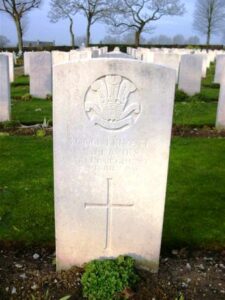
Samuel William Dunn, Lieutenant, Royal Navy. Samuel was born at Penarth on 24 September 1876, the son of John and Margaret Dunn. His father John was a Boatswain with the Coastguard, and moved the family to Burry Port, where he took up a new post with the Coastguard. Samuel followed in his fathers footsteps, and took to the seas, joining the Royal Navy. By the time of the Great War, Samuel was serving as a Lieutenant aboard HMS Topaze, an old armoured Cruiser, which was based in the Mediterranean and the Red Sea. Samuel took ill while in the Mediterranean, and died on 10 July 1918, aged 42. He is buried at Taranto Town Cemetery Extension, Italy, as Taranto was an important Royal Naval Base, holding a Naval Hospital. Samuel is not commemorated on the Burry Port Memorial, but his details were sent to me by his Great Nephew, Stephen Dunne for inclusion on the site.
David Edmunds, Master, Mercantile Marine. David was born at Burry Port in 1871, the son of Joseph and Mary Edmunds. He married Elizabeth Ann Randell in 1902, and the couple resided at Kidwelly with their daughter. David served in the Mercantile Marine as Master of the SS Tangistan. Tangistan SS was a 3,738grt, British Merchant ship. On 9 March 1915, Tangistan was on route from Benisaf to the Tees when she was torpedoed without warning by the German submarine U-12 and sunk. Thirty lives were lost including David. He was 44 years old and is commemorated on the Tower Hill Memorial, London. David is shown standing on the right in the photograph, along with his parents, his wife, and their only daughter.
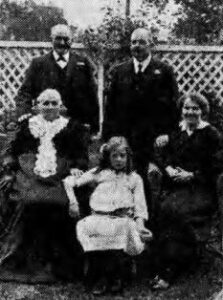
David Gwynne Edmunds, Captain, Welsh Regiment. David was the son of William Price Edmunds and Elizabeth A. Edmunds, of Anchor House, Burry Port. He originally enlisted into the Pembroke Yeomanry, and served with a Motor Despatch unit before being commissioned into the 18th Battalion, Welsh Regiment. The Battalion was attached to 119 Brigade, 40th (Bantam) Division, which was formed between September and December 1915, composed of bantam units and others which had a mixture of regulation-height and shorter men. Weeding out of very under-sized or unfit men delayed the training programme, and it was not until late Spring 1916 that the Division was ready to proceed on active service. The Division moved to France during June 1916, and moved to the front near Loos. Late in 1916 they moved south to the Somme, and fought at the Battle of the Ancre, and remained in the area over the winter. In March, 1917 the Germans withdrew to their shortened line, called the Hindenburg Line, and the 40th Division were one of the Divisions that followed the withdrawal. Later in the year they took part in the Battle of Cambrai, playing an important role in the attack on Bourlon Wood. David was killed at Cambrai on 25 November 1917, aged just 21. He has no known grave, and so is commemorated on the Cambrai Memorial, Louverval, France.
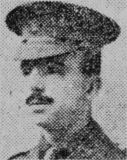
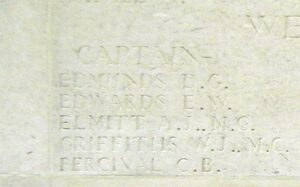
Joseph Emery, Steward, Mercantile Marine. Joseph was the husband of Elizabeth Emery, the daughter of Anne Evans, of 53, Burrows Terrace, Burry Port. He was a long serving sailor, and was serving aboard the SS Kingsley. On 2 January 1918 Kingsley was steaming off Cornwall when she was attacked by a German U-Boat. The Germans fired several shots at the ship using their deck gun, and caused substantial damage before the Kingsley managed to escape, and head for safety at Penzance. Joseph was one of four men killed during the attack that day. He was 50 years old, and his remains were brought back to be buried with full military honours at Pembrey (St. Illtyd) Churchyard.
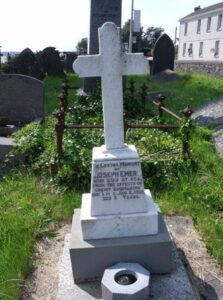
William Evans, Lance Corporal, 39848, Welsh Regiment. William was the son of John and Ann Evans, of 41, Pencoed Road, Burry Port, and enlisted at Swansea into the 8th Battalion, Welsh Regiment. The Battalion were attached to 40 Brigade, 13th (Western) Division. On 13 June 1915 the first transports carrying the Division left port, and moved to Alexandria, and by July the Division was on the Gallipoli Peninsula. After suffering ehavily at Gallipoli over the coming months, the Division was evacuated from Suvla on 19 December 1915, whereupon the infantry moved after a weeks rest to the Helles bridgehead, where they faced the last Turkish attacks at Helles. On 8 January 1916, the Division was evacuated from Helles, and by 31 January was concentrated at Port Said, where they held forward posts in the Suez Canal defences. On 12 February 1916 the Division began to move to Mesopotamia, to strengthen the force being assembled for the relief of the besieged garrison at Kut al Amara. By 27 March, the Division had assembled near Sheikh Saad and came under orders of the Tigris Corps, and then took part in the attempts to relieve Kut. However, after these efforts failed and Kut fell, the British force in the theatre was built up and reorganised. William died of sickness in Mesopotamia on 15 July 1916. He was just 21 years old, and is buried at Amara War Cemetery, Iraq.
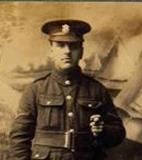
Tom Charles Fuller, Private, 7719, Welsh Regiment. Tom was the son of Clement and Lizzie Fuller, of Swansea. By 1911 he was living with his uncle, William Bowen, at 79, New Street, Burry Port. He is listed as residing at Ystradgynlais prior to enlisting into the 2nd Battalion, Welsh Regiment, which was part of 3 Brigade, 1st Division. The Division had been one of the first to arrive in France, fighting at the Battle of Mons, and taking part in the retreat to the Marne, where the Germans were stopped. They then fought at the Aisne, and at Chivy, before being moved North to Ypres. Here they fought at the First Battle of Ypres, and it was here that Tom was probably wounded. He was moved to the Base Hospital at Wimereux where he sadly died of wounds on 7 November 1914, aged 32. Tom is buried there at Wimereux Communal Cemetery, France. He was the cousin of William Fuller of Laugharne and Swansea, the first Welshman to win the Victoria Cross during the Great War.

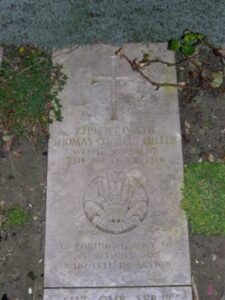
Adam Gillespie, Sapper, 158291, Royal Engineers. Adam was the son of John and Mary Gillespie, of Drumlemble, Campbeltown, and resided at Burry Port prior to the war, where he worked as a collier. He enlisted at Llanelli into the Royal Engineers, and was posted to the 257th Tunnelling Company. This Tunnelling Company was involved in mining operations in the Neuve Chapelle area early in 1917, and this is where Adam died, aged 38, on 1 March 1917. He is buried at La Gorgue Communal Cemetery, France.
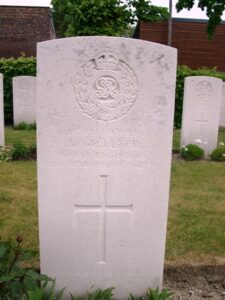
Joseph Gower, Private, 72989, Kings Liverpool Regiment. Joseph was born on 23 October 1896, the son of David and Hannah Gower, of 4, East Cottages, Burry Port, and enlisted there into the 4th Battalion, Welsh Regiment. He was probably posted to France in the spring of 1918, joining the 1st Battalion, Kings Liverpool Regiment, which was part of 6 Brigade, 2nd Division. The division was caught up in the Battle of St Quentin, during the German spring offensive, and took part in the retreat back towards Arras. In August they took part in the launching of the great offensive, and fought in the Battle of Albert, which is where Joseph was killed in action on 25 August 1918, aged 21. He has no known grave, and so is commemorated on the Vis-En-Artois Memorial, France.

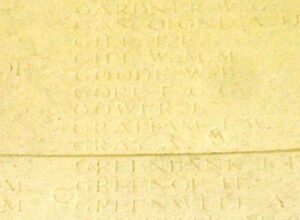
Frank Griffiths, Sapper, 204515, Royal Engineers. Frank was born in Burry Port, the son of David John Gibson Griffiths and Caroline Griffiths. After 1901 the family had moved to 32, Hedley Terrace, Llanelli. Frank enlisted at Llanelli on 7 November 1916 into the Royal Engineers, and landed in France on 14 May 1917, where he was posted to the 134th Army Troops Company, Royal Engineers. The Army Troops Companies were established similar to Field Companies, but for behind-the-lines bridging and water work. Frank was at Ypres during the Battle of Passchendaele, when he was killed in action on 4 October 1917. He was just 20 years old, and is buried at Canada Farm Cemetery, Belgium. Frank is not commemorated at Burry Port.
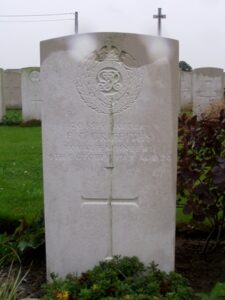
Trevor Griffiths, Gunner, 161221, Royal Garrison Artillery. Trevor was the son of Lewis and Elizabeth Anne Griffiths of Stepney Road, Burry Port. Trevor enlisted at Llanelli into the Royal Garrison Artillery, and was posted to France with their 133rd Siege Battery. Trevor was killed in action during the Battle of the Menin Road, on 24 September 1917, aged 18. He is buried at Menin Road South Military Cemetery, Belgium.
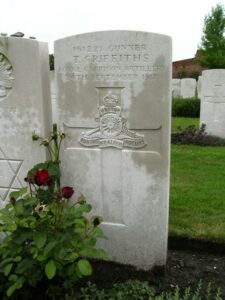
Thomas John Hawkins, Private, 10895, Welsh Regiment. Thomas was the son of Harry and Martha Jane Hawkins, of 50, Spring Gardens, Burry Port. He enlisted at Pontypridd into the 2nd Battalion, Welsh regiment, which was attached to 3 Brigade, 1st Division. The Division had been one of the first to arrive in France, fighting at the Battle of Mons, and taking part in the retreat to the Marne, where the Germans were stopped. They then fought at the Aisne, and at Chivy, and Thomas was killed there, during the Actions on the Aisne Heights, on 19 September 1914. He was 21 years old, and is buried at Braine Communal Cemetery, France.
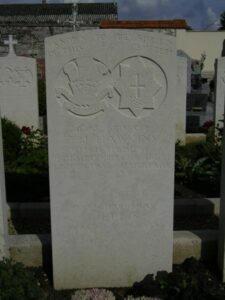
Charles Edward Hewitt, Private, T/3269, East Kent Regiment (The Buffs). Charles was born in Derbyshire, the son of Albert and Elizabeth Hewitt. By 1911 the family was residing at Pontardulais, before moving to Burry Port prior to the war. Charles enlisted at Llanelli into the 5th Battalion, Worcester Regiment, but later transferred into the 5th Battalion, East Kent Regiment. The Battalion embarked on 29 October 1914 to India as part of the Home Counties Division. The Division was broken up on arrival in Bombay, and the Battalion joined the Jubbulpore Brigade in 5th (Mhow) Division. In November 1915 it transferred to the 35th Brigade in 7th (Meerut) Division in Mesopotamia. Charles died in Mesopotamia on 27 April 1916, aged 18. He is buried at Amara War Cemetery, Iraq.
William Frank Howe, Private, 83080, Royal Fusiliers. William was the son of William Dudley Howe and Ada Amelia Howe, of 11, Glanmor Terrace, Burry Port. He enlisted at Llanelli into the Training Reserve, and was then posted to the 3rd Battalion, Royal Fusiliers. William must have been among a batch of reinforcements after 15 July 1918 to 149 Brigade, 50th Division. After suffering particularly heavy casualties while on the Aisne, the Division had been substantially reorganised. William was killed in action during the Battle of Amiens, on 11 August 1918. He was just 19 years old, and is buried at Dive Copse British Cemetery, Sailly-Le-Sec, France.
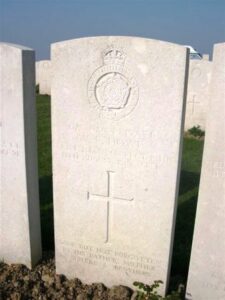
David Walter Hughes, Private, 23531, Dorsetshire Regiment. David was the son of John and Margaret Hughes, of 25, Old Castle Road, Llanelli. He married Henrietta Howell, of Goring Villa, 21, Ellington Road, Burry Port in 1914. David had been an Ironmonger’s Assistant prior to enlisting at Llanelli into the 6th Battalion, Dorsetshire Regiment. The Battalion was attached to 50 Brigade, 17th (Northern) Division, which had been in France since 17 July 1915. They spent their initial period of trench familiarisation and then holding the front lines in the southern area of the Ypres salient. Here they took part in fighting at the Bluff during February 1916 before moving south, and took part in the opening day of the Battle of the Somme, capturing Fricourt at heavy cost. The division saw action during the Battle of Arras, at the First and Second Battles of the Scarpe, before moving back to Ypres, and taking part in the Battle of Passchendaele. In March 1918 the Division was on the Somme, and was hit hard during the German offensive which was launched on 21 March. After a period out of the line to rest and rebuild, the Division moved to the southernmost sector of the Somme area, and fought at the Battle of Amiens on 8 August 1918, a day which saw the war swing in the favour of the Allies. The Allies then advanced on the Somme, and the Division fought at the Battle of Albert later that month. It was here that David was killed in action on 24 August 1918. He was 26 years old, and is buried at Mill Road Cemetery, Thiepval, France.
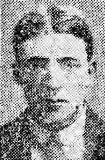
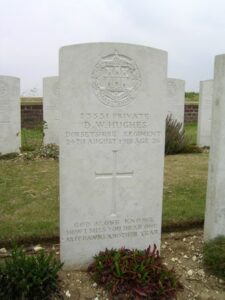
Sidney Isaac, Private, 19871, Welsh Regiment. Sidney was the son of James and Lizzie Isaac, of 1, Bryn Terrace, Pembrey. He enlisted at Llanelli into the 15th Battalion, Welsh Regiment. The Battalion formed as the Carmarthenshire Battalion, and became part of 114 Brigade, 38th (Welsh) Division. The Division had landed in France during December 1915 and had spent their first winter in the trenches near Armentieres. In June they marched south to the Somme, where they were tasked with the capture of Mametz Wood. The attack on the wood began on 7 July 1916, but met with fierce resistance, and it took almost a week of hard fighting to clear the wood. Sidney was killed in action at Mametz Wood during the second assault, on 10 July 1916, aged 19. He has no known grave, and so is commemorated on the Thiepval Memorial, France.

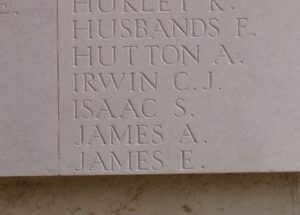
Joseph Henry James, Private, 201642, Royal Berkshire Regiment. Joseph was the son of David and Annie James, of Castle Street, Steventon, Berkshire. He worked for the Great Western Railway at Burry Port prior to the war, and had married Frances Hannah James in 1914. He enlisted at Abingdon into the 2nd Battalion, Royal Berkshire Regiment, which was attached to 25 Brigade, 8th Division. The Division had been in France since November 1914, a badly-needed reinforcement to the BEF which had been all but wiped out at Ypres. They saw their first major action at the Battle of Neuve Chappelle, and then at the Battle of Aubers. They then saw further fighting at the Action of Bois Grenier, before moving to the Somme in 1916, where they fought at the Battle of Albert. In March 1917 they followed the German Retreat to the Hindenburg Line, and later that year moved to Ypres, fighting at the Battle of Pilckem, and the Battle of Langemarck. In March 1918 the Division were on the southern end of the Somme, and here met the German Offensive head on, at the Battle of St Quentin. Joseph was killed in action here on 2 April 1918, aged 24. He has no known grave, and so is commemorated on the Pozières Memorial, France.
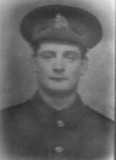
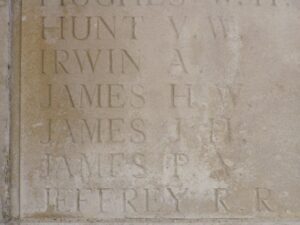
Cadvan Francis Jones, Private, 131069, Machine Gun Corps. Cadvan was the son of David Francis and Ann Jones, of Pentre Ystrad (Rhondda). He worked as a collier at Burry Port prior to the war and in 1916 married Elizabeth Mary Jenkins, of 9, Williams Terrace, Burry Port. He had originally enlisted at Llanelli into the Welsh Regiment, and had later been transferred into the Machine Gun Corps. Cadvan was killed in action during the Battle of Albert on 27 August 1918. He was 29 years old and is buried at Fienvillers British Cemetery, France.
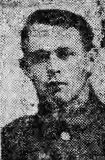
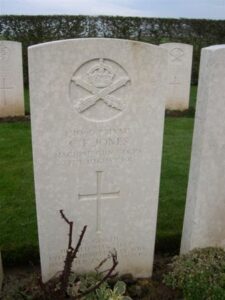
George Albert Lewis, Private, 1895, Welsh Guards. George was the son of John and Sarah Lewis, of 40, Station Road, Burry Port. His details with the CWGC state that he was originally rejected as unfit, and underwent an operation in Llanelli Hospital to render himself “fit”. George then enlisted into the 1st Battalion, Welsh Guards, attached to the 3rd Brigade, Guards Division. This Division has the distinction of being formed in France in August 1915, and remained on the Western Front throughout the war, seeing its first major action during the Battle of Loos on 25 September 1915. It remained in the area during the coming months, where they also fought in the subsequent Action of Hohenzollern Redoubt. They then spent a brief period at Ypres, and George was soon wounded. He died of wounds on 22 March 1916, aged 24, and is buried at Brandhoek Military Cemetery, Belgium.

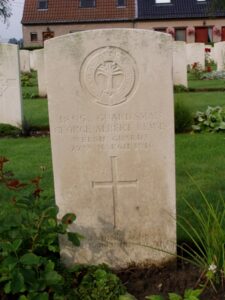
Isaac Lewis, Private, 12678, South Wales Borderers. Isaac was born at Pwll, the son of David and Sarah Lewis. His wife Priscilla died in 1911, leaving Isaac to raise their five children alone. Isaac enlisted at Llanelli into the 1st Battalion, South Wales Borderers. The Battalion was attached to 3 Brigade, 1st Division, which had been one of the first to arrive in France, fighting at the Battle of Mons, and taking part in the retreat to the Marne, where the Germans were stopped. They then fought at the Aisne, and at Chivy, before being moved north to Ypres. Here they fought at the First Battle of Ypres, where they again stopped the German Offensive, before wintering in Flanders. The following year saw them in action again at the Battle of Aubers, before moving South to Loos, where they fought during the Battle of Loos, and the action at the Hohenzollern redoubt. Isaac was killed in action during the following months in the line at Loos, on 29 June 1916, aged 39, and is buried at Bully-Grenay Communal Cemetery, British Extension, France.
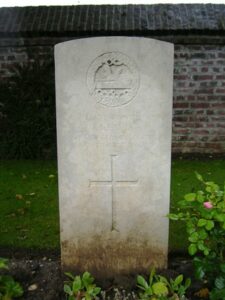
Ivor Idris Lewis, Private, 20853, Welsh Regiment. Ivor was born at Burry Port, the son of Theophilus and Catherine Lewis, later of Rostella, Pontyates. He enlisted at Llanelli into the 15th Battalion, Welsh Regiment. This was the Carmarthen Pals Battalion, and became part of 114 Brigade, 38th (Welsh) Division. The Division had landed in France during December 1915 and had spent their first winter in the trenches near Armentieres. In June they marched south to the Somme, where they were tasked with the capture of Mametz Wood. The attack on the wood began on 7 July 1916, but met with fierce resistance, and it took almost a week to clear the wood. The Division suffered terrible casualties at Mametz, and were taken out of the line, and moved to Ypres to rebuild. Here they took part in the Battle of Pilckem Ridge on 31 July 1917, where Ivor was wounded. He died of wounds on 1 August 1917, aged 23, and is buried at Brandhoek New Military Cemetery, Belgium.
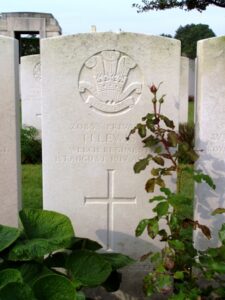
Thomas Llewellyn McFadden, Second Mate, Mercantile Marine. Thomas was born at Mostyn, North Wales the son of James and Mary Ann McFadden. The family had resided at St Dogmaels before moving to 40, Sandfield Row, Burry Port. Thomas served in the Mercantile Marine aboard the SS Framfield. Little is known about the ship, except that it struck a German mine and sank on 24 October 1916. Thomas drowned aboard her that day aged 23, and is commemorated on the Tower Hill Memorial, London.
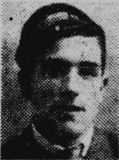
William John Morgans, Private, 73779, Royal Welsh Fusiliers. William was born at Burry Port, the son of David and Easter Morgans. The family later resided at The Blue Anchor, Pwll, but William was brought up with his grandfather, William Morgans, at 33, Sea View Terrace, Burry Port. William enlisted at Llanelli into army and in the summer of 1918 was posted to France, joining the 14th Battalion, Royal Welsh Fusiliers, which was attached to 113 Brigade, 38th (Welsh) Division. The Division had landed in France during December 1915 and had fought at Mametz Wood in 1916, before capturing Pilckem Ridge in 1917. The division took part in the great offensive on the Somme from 21 August 1918 onwards, during the Battle of Albert, and then moving east, where they fought at the Battle of Bapaume. Then the move began towards the mighty Hindenburg Line, and the Division carried on with their march east, fighting at the Battle of Havrincourt, and the Battle of Épehy. A short rest period ensued, during which time the Canal du Nord was breached, so opening a passage through the Hindenburg Line. The Division then fought at the Battle of Beaurevoir, where William was killed in action on 7 October 1918, aged 18. He is buried at Bois-Des-Angles British Cemetery, Crevecoeur-Sur-L’escaut, France.
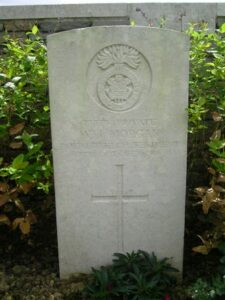
John Mycock, Able Seaman, R/4176, Royal Naval Division. John was born on 11 March 1894, the son of William and Margaret Mycock, of Llanllechid, North Wales. He married Rachel Ann John, of 119 Pencoed Road, Burry Port in the summer of 1916. John served in the Royal Naval Reserve, with the Nelson Battalion, Royal Naval Division. The Naval Brigades were originally sent to Antwerp and Dunkirk in September and October 1914 to guard against invasion by the Germans. However Antwerp fell to the Germans soon after, and so many of the RND units were withdrawn to England. After a lengthy period of refit and training the Division moved to Egypt preparatory to the Gallipoli campaign. Landing on 25 April 1915 the Division was soon transferred from the authority of the Admiralty to the War Office on 29 April 1916, and was redesignated the 63rd (Royal Naval) Division on 19 July 1916. The Division moved to France, arriving at Marseilles during May 1916 and moved to positions on the Somme, where it took part in the Battle of the Ancre, and the resulting Operations on the Ancre. In April 1917 the Division were at Arras, and fought at the Second Battle of the Scarpe, where they captured Gavrelle. They then fought at the Battle of Arleux, before moving north to Ypres, where they took part in the Second Battle of Passchendaele. Their next major action was at Cambrai, during the Action of Welsh Ridge, which is where John was killed on 31 December 1917. He was 23 years old, and is buried at Marcoing British Cemetery.
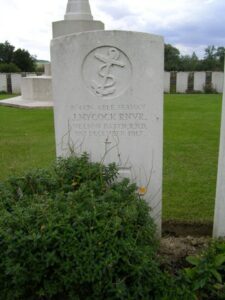
James Northey, DCM, Sergeant, 9563, Welsh Regiment. James was the son of John and Elizabeth Northey of Gelli Ystrad. He was a pre war regular with the Welsh Regiment and had married Beatrice Jane Allen in 1915. He had enlisted at Cardiff into the 2nd Battalion, Welsh Regiment, which was attached to 3 Brigade, 1st Division. The Division had been one of the first to arrive in France, fighting at the Battle of Mons, and taking part in the retreat to the Marne, where the Germans were stopped. They then fought at the Aisne, and at Chivy, before being moved north to Ypres. Here they fought at the First Battle of Ypres, where they again stopped the German Offensive, before wintering in Flanders. The following year saw them in action again at the Battle of Aubers, before moving South to Loos, where they fought during the Battle of Loos, and the action at the Hohenzollern redoubt. Again they were required for a major offensive, moving south to the Somme, where they fought during the opening of the Somme Offensive at the Battle of Albert, then at Bazentin, Pozieres, Flers-Courcelette and Morval. James was wounded on the Somme, and brought back to the Army Hospital at Merthyr, where he died of wounds on 8 October 1916. He was 35 years old, and is buried at Merthyr Tydfil (Beech Grove) Cemetery. James had been awarded his Distinguished Conduct Medal for gallantry at Ypres. The Citation read; ‘For conspicuous gallantry when he went out four times over the front parapet under heavy rifle fire at about 150 yards range and successfully brought in four wounded men. James is not commemorated locally, but his widow Beatrice remarried David William Aston in 1922, and moved to 9, Colby Road, Achddu, Burry Port.
Herbert Samuel James Owen, Private, 19883, Welsh Regiment. Herbert was the son of Charles Herbert and Annie Owen, of 8, Gors Road, Burry Port. He enlisted in November, 1915 into the 15th Battalion, Welsh Regiment, the Carmarthen Pals Battalion, which became part of 114 Brigade, 38th (Welsh) Division. The Division had landed in France during December 1915 and had spent their first winter in the trenches near Armentieres. In June they marched south to the Somme, where they famously captured Mametz Wood. The Division suffered terrible casualties at Mametz, and were taken out of the line, and moved to Ypres to rebuild. Herbert was killed in action in Flanders on 7 June 1917. He was 23 years old, and is commemorated on the Ypres (Menin Gate) Memorial, Belgium.
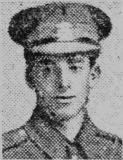
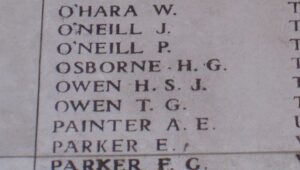
William Henry Perrin, Gunner, 203342, Royal Field Artillery. William was born on 25 October 1894, at St. Lythans Downs, St. George, Glamorgan, the son of James and Elizabeth Perrin (nee Fouracre). His father James worked as a tunnel miner, working on the mineral line railways, and powder works railway during the war. James lost his wife Elizabeth in 1896, re-marrying Melita Gunning, of The Bungalow, Derwydd, Burry Port, where William was raised. William enlisted at Pembrey into the Royal Field Artillery, and was posted to France where he joined the 505th Battery, 65th Brigade. William was killed in action during Third Ypres, the Battle of Passchendaele, on 3 October 1917. He was 32 years old, and is commemorated on the Tyne Cot Memorial, Belgium. Many thanks to Janet Herridge for the photo of William.
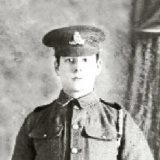
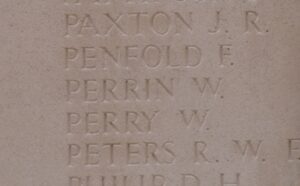
Thomas Power, Private, 19778, Welsh Regiment. Thomas was born at Tonypandy and lived at Burry Port with his wife Mabel. He enlisted at Gelli into the 9th Battalion, Welsh Regiment. The battalion landed in France in July 1915 attached to 58 Brigade, 19th (Western) Division. The Division moved to positions near Loos, where it took part in the opening attack of the Battle of Loos on 25 September 1915. The following year the Division moved to the Somme, where it took part in the second wave of the attack on Ovillers-La Boiselle on 1 July, capturing the village at heavy cost. Thomas was wounded at La Boiselle, and evacuated to the Casualty Clearing Station at Puchevillers, where he died on 12 July 1916. He is buried at Puchevillers British Cemetery, France. Thomas is not commemorated locally.
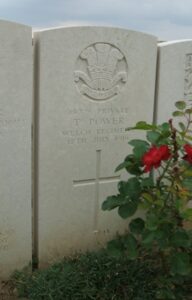
Lemuel Price, Private, 201543, Royal Welsh Fusiliers. Lemuel was the son of James and Elizabeth Price, of 60, Pencoed Road, Burry Port. He enlisted at Llanelli into the Welsh Regiment, but later transferred into the 19th Battalion, Royal Welsh Fusiliers, who were attached to 110 Brigade, 40th (Bantam) Division. This Division was formed between September and December 1915, composed of bantam units and others which had a mixture of regulation-height and shorter men, and moved to France during June 1916, and moved to the front near Loos. Late in 1916 they moved south to the Somme, and fought at the Battle of the Ancre, and remained in the area over the winter. In March 1917 the Germans withdrew to their shortened line, called the Hindenburg Line, and the 40th Division were one of the Divisions that followed the withdrawal. Lemuel was wounded whilst the Battalion were in the line, and died of wounds on 11 August 1917. He was 32 years old, and is buried at Rocquigny-Equancourt Road British Cemetery, Manancourt, France.
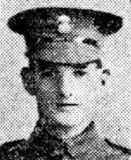
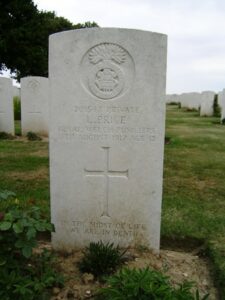
Richard Price, Private, 5089, Welsh Regiment. Richard was the son of Richard and Mary Price, of Revelfach, Pembrey. He married Margaret Gower in 1903, and the couple resided at 2, Mount Pleasant, Burry Port. Richard enlisted at Llanelli into the 1/4th Battalion, Welsh Regiment. The Battalion was formed at Carmarthen during August, 1914 and became attached to 159 Brigade, 53rd (Welsh) Division. The Division moved to the Mediterranean, sailing from Devonport in July 1915, and landed at Cape Helles, Gallipoli on 9 August 1915. Here they immediately faced the chaotic leadership that was to lead to the ultimate failure of the campaign, and spent the next few days in isolated pockets, fighting against a Turkish counter-attack. Richard was wounded at Gallipoli and evacuated to Mudros Island for treatment. He sadly died of wounds on 23 August 1915, aged 30, and is buried at East Mudros Military Cemetery.
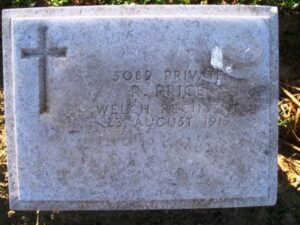
Frederick Thomas Randell, Gunner, 124099, Royal Garrison Artillery. Frederick was the son of Charles Thomas and Sarah Randell, of 82, Elkingon Road, Burry Port, and he enlisted there into the Royal Garrison Artillery. Frederick was posted to the 33rd Siege Battery, and moved to the Western Front. He was wounded during the Battle of Arras (The Battle of Hill 70), and died of wounds on 14 August 1917, aged 21. He is buried at Noeux-Les-Mines Communal Cemetery, France.
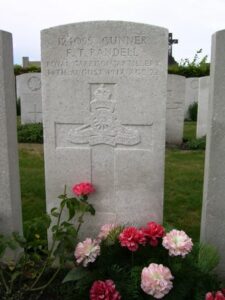
Albert Rees, Private, 4641, Pembroke Yeomanry. Albert was the son of William and Elizabeth Rees, of 37, Cliff Terrace, Ashburnham Road, Burry Port. He served with the Pembroke Yeomanry, which was attached to the 1st Mounted Division. Albert didn’t get the chance to go overseas with the Battalion, and instead died at home of sickness on 16 June 1915. He was just 19 years old, and is buried at Pembrey (St. Illtyd) Churchyard.
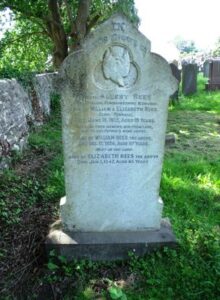
David Edmunds Rees, Engineer, Mercantile Marine. David was the son of David and Mary Rees, of 27, Church Road, Burry Port. He served in the Mercantile Marine aboard the SS Camelata, and he was killed aboard her when she was torpedoed and sunk by a German Submarine on 2 May 1917. David was 24 years old, and is commemorated on the Tower Hill Memorial, London.
George James Rees, Private, 40019, Welsh Regiment. George was the son of Evan and Hannah Rees, of 18, Silver Row, Burry Port, and he enlisted at Llanelli into the 2nd Battalion, Welsh Regiment, which was attached to 3 Brigade, 1st Division. The Division had been one of the first to arrive in France, fighting at the Battle of Mons, and taking part in the retreat to the Marne, where the Germans were stopped. They then fought at the Aisne, and at Chivy, before being moved north to Ypres. Here they fought at the First Battle of Ypres, where they again stopped the German Offensive, before wintering in Flanders. The following year saw them in action again at the Battle of Aubers, before moving South to Loos, where they fought during the Battle of Loos, and the action at the Hohenzollern redoubt. Again they were required for a major offensive, moving south to the Somme, where they fought during the opening of the Somme Offensive at the Battle of Albert, then at Bazentin, Pozieres, and Flers-Courcelette. George was killed in action around this time, on 24 August 1916. He was 24 years old, and is commemorated on the Thiepval Memorial, France.
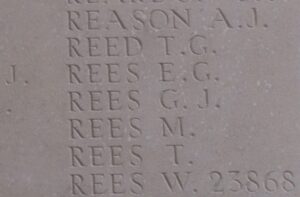
John Rees, Lance Corporal, 5297, Royal Welsh Fusiliers. John was born at Burry Port, and he enlisted at Liverpool into the 1st Battalion, Royal Welsh Fusiliers. The Battalion were in India at the outbreak of war, and quickly returned to the UK, landing at Southampton on 3 September, 1914. Here they were attached to 22 Brigade, 7th Division and landed at Zeebrugge on 6 October 1914. The City was already falling however, and so the Division was moved to Ypres, where they became the first British Division to hold the city. They fought during the First Battle of Ypres, and helped stop the German advance through Belgium, and in March 1915 fought at the Battle of Neuve Chapelle. During May they fought at the Battle of Aubers Ridge, and at Festubert, before taking part in the Battle of Loos in September. The Division took part in the initial assault north of the Vermelles-Hulluch road, in the sector facing the Quarries and a series of strong-points. Suffering badly from British cloud gas, which was not moved sufficiently by the gentle breeze, and badly cut up by German machine gun fire and artillery, the Division nonetheless seized the Quarries and only failed to penetrate the third German line due to the relative weakness of the numbers of men that got through. John was killed in action at Loos on 25 September 1915, and is commemorated on the Loos Memorial, France. John is not commemorated locally.
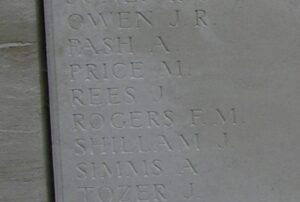
Thomas Rees, Private, 13157, Royal Welsh Fusiliers. Thomas was the son of John and Jane Rees, of 15, Williams Terrace, Burry Port, and he enlisted at Llanelli into the 9th Battalion, Royal Welsh Fusiliers. The Battalion was attached to 58 Brigade, 19th (Western) Division, which crossed to France during July 1915, and moved to positions near Loos. Here they took part in the Battle of Loos, and attacked the German lines north of Givenchy on 25 September 1915, suffering terrible casualties from machine-gun fire. Thomas was one of many men killed that day. He was 29 years old, and is commemorated on the Loos Memorial, France.
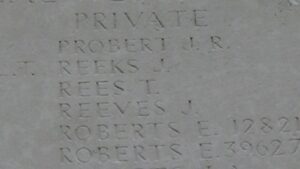
William Roberts, Private, 202701, Welsh Regiment. William was the son of Thomas and Margaret Roberts, of Brynhydref, Park Terrace, Burry Port. He enlisted at Carmarthen into the 15th Battalion, Welsh Regiment, the Carmarthen Pals Battalion, which had been in France since December 1915 attached to 114 Brigade, 38th (Welsh) Division. The Division had famously captured Mametz Wood in July 1916, and the Pilckem Ridge in July 1917, and the 15th Welsh also fought at Langemarck with the 20th (Light) Division. The Division then moved to Armentieres, where they remained from September 1917 until March 1918, when the German Spring Offensive was launched. The British had been over-run on the Somme, and so in April the Division was moved south, taking up positions North of Albert, from where they weathered the storm of the coming months, until the war turned during the Battle of Amiens, on 8 August 1918. The Germans had now lost the upper hand, and the British regained the lost ground on the Somme after an attack which began on 21 August 1918, when the 15th Welsh crossed the flooded River Ancre and, with the 38th Welsh Division, captured Thiepval and Pozieres. William was killed in action less than a week into the advance, whilst fighting near High Wood on 26 August 1918. He was 28 years old and is commemorated on the Vis-En-Artois Memorial, France.
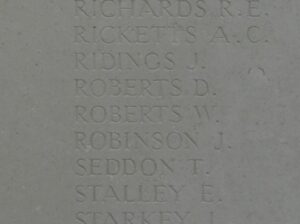
Allan Whitlock Nicholl Roderick, Lieutenant, Welsh Regiment. Alan was born on 23 October 1895, the third son of William and Ella Augusta Buckley Roderick, of Goodig, Pembrey. He was educated at Rugby School, with the intention of entering the family business as a solicitor. Allan enlisted into the 4th Battalion, Welsh Regiment at the outbreak of war, and by July 1915 had been promoted Lieutenant. The 4th Welsh had formed for war at Carmarthen in August 1914. The battalion was attached to 159 Brigade, 53rd (Welsh) Division, and sailed from Devonport in July 1915 arriving at Mudros by 5 August, 1915. From here they moved to Gallipoli, landing on 9 August 1915. Here they immediately faced the chaotic leadership that was to lead to the ultimate failure of the campaign, and spent the next few days in isolated pockets, fighting against a Turkish counter-attack. Alan was killed in action while leading some men at Chocolate Hill on 10 August 1915, aged 19. He has no known grave, and is commemorated on the Helles Memorial, Gallipoli.
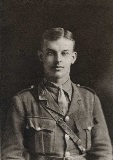
Hume Buckley Roderick, Captain, Welsh Guards. Hume was born on 17 June 1887, the eldest son of William and Ella Augusta Buckley Roderick, of Goodig, Pembrey. He was educated at Parkfield School, Hayward’s Heath, and at Rugby, where he was a member of the Cricket XI. He later qualified as a Solicitor, and was a member of the firm of Roderick and Richards, Llanelli. At the outbreak of war, Hume was a Captain with the 4th Welsh, stationed at Pembroke Dock. He went with the Welsh to Gallipoli, attached to the 53rd (Welsh) Division, but was invalided home due to illness. Hume then returned to Egypt to rejoin his Battalion in 1916, and later that year returned home again, to take up a Commission in the Welsh Guards. Meanwhile, whilst back in the UK, on 9 November 1916 he married Barbara Garnons-Williams, daughter of the late Lieutenant-Colonel R. D. Garnons-Williams, who had been killed at Loos the previous year. The couple set up home at Tegfan, Devynock, Breconshire. Hume joined his new Battalion on the Western Front in December 1916 and took command of No. 3 Company, 1st Battalion, Welsh Guards. In July 1917 Hume was wounded at Ypres, but remained at the front, and moved with the Battalion from Ypres to positions near Cambrai, where they fought at the Battle of Cambrai throughout November and December, 1917. Hume was killed in action at Cambrai on 1 December 1917, whilst leading his Platoon on a charge against a German Machine Gun Post. He was 30 years old, and is buried at Gouzeaucourt New British Cemetery, France.
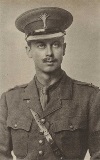
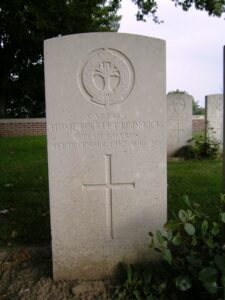
John Victor Tweed Roderick, Lieutenant, Coldstream Guards. John was the fourth son of William and Ella Augusta Buckley Roderick, of Goodig, Pembrey. He was educated at Rugby School prior to being commissioned into the Pembroke Yeomanry in 1915. He served in Ireland before being posted to Egypt, where the Pembroke Yeomanry held positions on the Suez Canal. In March 1917 John transferred to the Coldstream Guards, and was posted to France in December, joining the 1st Battalion, which was part of 1st Brigade, Guards Division. The division was in the Cambrai sector, after having recently fought in the Battle of Passchendaele and the Battle of Cambrai. They remained in the area over the final winter of the war, and were stationed near Gouzeaucourt when the German Spring Offensive hit the area on 21 March 1918, at the Battle of St Quentin. The British retreated in the face of this onslaught, fighting at the First Battle of Bapaume, before the Guards Division retreated west and faced the Germans at the First Battle of Arras, 1918. After this, the German Offensive petered out on the Somme, and on 8 August 1918 the Allies advanced towards the town of Villers Brettoneux and won a mighty battle there against the Germans, thus turning the war. On 21 August 1918 the British launched an attack on the Somme, and this is where John was killed in action on 27 August 1918, while leading an attack against the village of Moyenneville. He was 21 years old, and is buried at Bac-Du-Sud British Cemetery, Baillieulval, France.
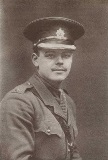
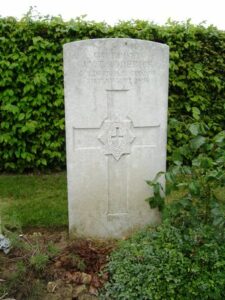
John Erasmus Rowlands, Gunner, 150556, Royal Garrison Artillery. John was the son of Frank and Mary Ann Rowlands, of 63, New Street, Burry Port, and he enlisted at Neath into the Royal Garrison Artillery. John served with the 101st Heavy Battery, which was part of the 64th Brigade, RGA attached to the Second Army. The Second Army was at Ypres during the summer of 1917, preparing for the great battles of Third Ypres, when John was killed in action on 8 June 1917. He was 29 years old, and is buried at Hop Store Cemetery, Belgium.
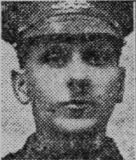
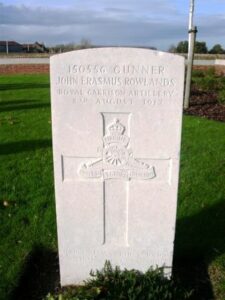
John Gwynfor Rowlands, Private, 99865, Machine Gun Corps. John was the son of David and Margaret Anne Rowlands, of 17, New Street, Burry Port. He enlisted at Llanelli into the Monmouth Regiment, but later transferred into the 34th Battalion, Machine Gun Corps, which was attached to the 34th Division. The Division moved to France during January 1916, and saw its first major action on the Somme, during the Battle of Albert, where it suffered very severe casualties during its part in the attack on La Boisselle. It then took part in the Battle of Bazentin, Battle of Pozieres and the Battle of Flers-Courcelette. The following year saw them fighting at Arras, during the First and Second Battles of the Scarpe, and the Battle of Arleux. In March 1918 the Division were in the St. Quentin sector, and were hit by the German Spring Offensive on 21 March. They fought here at the Battle of St Quentin, and this is where John was killed in action, on 21 March 1918. He was just 20 years old, and is commemorated on the Arras Memorial, France.

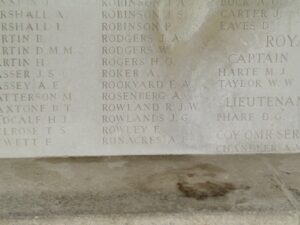
George Edward Scott, Private, 3016, Welsh Regiment. George was born at Bristol, the son of John and Mary Ann Scott. By 1901 the family had moved to 4, Bank Buildings, Llandeilo, where George and his brothers and sisters were educated. By the outbreak of war the family had moved to 37, Victoria Street, Llandovery, and George enlisted at Llandovery into the 1/4th Battalion, Welsh Regiment. On 17 April 1915 the battalion was attached to 159 Brigade, 53rd (Welsh) Division, and in July 1915, was shipped to Egypt, preparatory to landing at Suvla, Gallipoli on 8 August 1915. George was wounded soon after. He was evacuated to a Hospital Ship anchored off-shore, but sadly Died of Wounds at sea on 14 August 1915. He is commemorated on the Helles Memorial, Gallipoli. His brother John had been killed just three days earlier, and their father John had died while serving with the 2/5th Welsh.

John Scott, Sergeant, 3055, Welsh Regiment. John was born at Bristol, the son of John and Mary Ann Scott. By 1901 the family had moved to 4, Bank Buildings, Llandeilo, where John and his brothers and sisters were educated. By the outbreak of war the family had moved to 37, Victoria Street, Llandovery. John married Edith Atkins, of Llandebie in 1906, and the couple set up home at 59, Gorsddu Road, Penygroes. He enlisted at Llandeilo into the 1/4th Battalion, Welsh Regiment, which was attached to 159 Brigade, 53rd (Welsh) Division, and sailed in July 1915 for Egypt. On 8 August 1915 the Division landed at Suvla Bay, Gallipoli, and John was Killed in Action on 11 August 1915, aged 29, during the Battle of Sari Bair. He is commemorated on the Helles Memorial, Gallipoli. His brother George died three days later, and their father John had died while serving with the 2/5th Welsh.

John Scott, Private, 20102, Welsh Regiment. John was the son of George and Elizabeth Scott, of Kingswood Bristol, and the Husband of Mary Ann Scott, of 37, Victoria Street, Llandovery. He resided at Burry Port prior to the war, and enlisted at Llanelli into the 1/4th Battalion, Welsh Regiment. The Battalion had been formed at Carmarthen during August 1914 and were to become part of 159 Brigade, 53rd (Welsh) Division. The Division left for the Mediterranean during July 1915 but John remained at home, in hospital at Aberavon, suffering from illness. He became distraught following the deaths of his two sons, and killed himself there on 3 September 1915, aged 50. John is buried at Aberavon (St. Mary) Church Cemetery. The two of his sons who fell were George and John Scott.

Robert Scott, Private, 4338, Pembroke Yeomanry. Robert was the son of Robert and Mary Scott, of Lazenby, Cumberland, and the husband of Amy Scott, of Burry Port. He enlisted at Carmarthen into the Pembroke Yeomanry. The Pembroke Yeomanry arrived in Egypt in March 1916 as part of the 1st Mounted Division, and remained there until early 1917. Robert was attached to the 6th Company, Imperial Camel Corps, and he was wounded at some stage at the beginning of January 1917. Robert died of wounds on 9 January 1917, aged 37, and is buried at Kantara War Memorial Cemetery, Egypt.
Thomas Smith, Private, 15665, Royal Welsh Fusiliers. Thomas was born in Burry Port, and resided in Pontyberem prior to the war. He enlisted at Mountain Ash into the 10th Battalion, Royal Welsh Fusiliers, which were attached to 76 Brigade, 25th Division. The Division landed at Boulogne on 27 September 1915, and the Brigade then transferred to the 3rd Division. The Division was in Flanders at the time, and the 10th RWF saw their first action here at Bellewaarde and St. Eloi in 1916. They then moved south to the Somme, to take part in the great offensive there, and fought through the Battles of Albert, Bazentin, and Delville Wood. Thomas was killed in action on the Somme on 16 August 1916, and is buried at Guillemont Road Cemetery, Guillemont. Thomas is not commemorated on the Burry Port Memorial.
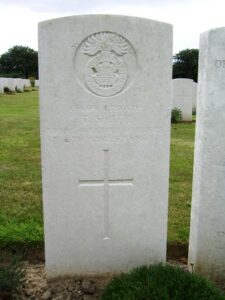
Archie Styles, Private, 45031, Welsh Regiment. Archie was the son of Charles and Emily Styles, of Old Shop, Mynydd y Garreg, Kidwelly. The family later moved to Crawley Down, Sussex, and Archie enlisted at Shoreditch into the 14th Battalion, Welsh Regiment. The Battalion was attached to 114 Brigade, 38th (Welsh) Division, and had landed in France during December 1915, spending their first winter in the trenches near Armentieres. In June they marched south to the Somme, where they captured Mametz Wood. The Division suffered terrible casualties at Mametz, and were taken out of the line, and moved to Ypres to rebuild. Here they fought at Pilckem and Langemarck, then moved to Armentieres, where they remained from September 1917 until March, 1918 when the German spring offensive was launched. The British had been over-run on the Somme, and so in April the Division was moved south, taking up positions North of Albert, where Archie was wounded. He died of wounds on 4 May 1918, aged just 21, and is buried at Harponville Communal Cemetery, France. Archie is also commemorated on the Kidwelly Memorial.
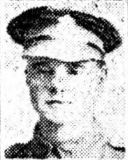

Robert Frederick Tate, Private, 32861, Welsh Regiment. Robert was born at Burry Port, the son of David and Frances Tate. By 1905 the family had moved to 38, Brynglas, Penydaren, Merthyr Tydfil. Robert enlisted at Merthyr into the 8th Battalion, Welsh Regiment, and served with them throughout the campaign at Gallipoli, and in Mesopotamia, before being transferred to the 2nd Battalion, Welsh Regiment, which was in France attached to 3 Brigade, 1st Division. They had been in France since the outbreak of war, and Robert probably joined them during the time of the German retreat to the Hindenburg Line in early 1917. The Division was then briefed for an operation on the Flanders Coast, and moved there during the summer of 1917. While training on the coast, the Battle of Third Ypres had stalled in the mire, and the Division were recalled to Ypres, where they fought at the Second Battle of Passchendaele. After spending another winter in Flanders, they were near Estaires when the German Spring Offensive caught them, fighting through the Battles of Estaires, Hazebrouck, and Bethune before being moved south again to Arras, fighting at the Battle of Drocourt-Queant, and at the Battle of Epehy, after the tide had been turned in the favour of the Allies. The Division pushed on towards the St. Quentin Canal, and after crossing the Hindenburg Line fought at the Battles of Beaurevoir, and the Selle, where Robert was killed in action on 23 October 1918, aged just 19. He has no known grave, and so is commemorated on the Vis-En-Artois Memorial, France. Robert is not commemorated at Burry Port.
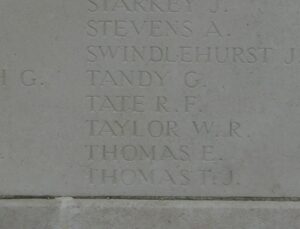
Joseph Robert Taylor, Sergeant, 7387, Royal Scots Fusiliers. Joseph was the son of Joseph and Elizabeth Taylor, of Co. Monaghan, and the Husband of Ann Taylor, of St. Ives, Burry Port. He enlisted at Swansea into the 1st Battalion, Royal Scots Fusiliers, which was attached to 9 Brigade, 3rd Division. One of the first Divisions to move to France, the 3rd Division remained on the Western Front throughout the war, and fought during the opening Battle of Mons, and in the epic retreat, from the Rearguard Action of Solesmes, through the Battle of Le Cateau, and down to the Marne, where the German Offensive was stopped. They followed the German withdrawal to the Hindenburg Line, where they met them in battle, and stopped the advance on Paris. The Division then moved north to Flanders, and took part in the Battle of La Bassée, and at the Battle of Messines, which were a prelude to the First Battle of Ypres. They took part in the famous Christmas Truce on 25 December 1914 and remained at Ypres throughout the winter. In 1915 the Division saw action at Bellewaarde and Hooge. Joseph was killed in action during this time at Ypres on 19 September 1915, aged 42, and is buried at Brandhoek Military Cemetery, Belgium.
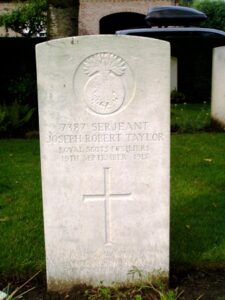
David James Thomas, Able Seaman, 197451, Royal Navy. David was born on 22 December 1882, the son of David Price Thomas and Caroline Fisher Thomas, of Bank Cottage Farm, Burry Port. He had served with the Royal Navy for several years prior to the war and lived with his wife Charlotte Betty Thomas, at 7, Hill Street, Dundee. David served with the Royal Navy aboard HM Submarine G7. She was on patrol in the North Sea when contact was lost with her on 23 October 1918. She was declared lost with all hands on 1 November 1918. David is now commemorated alongside his fellow crewmen on the Plymouth Naval Memorial, Devon. He had been a long servant to the Royal Navy, as he had gained his Long Service and Good Conduct Medal prior to his death. David is not commemorated at Burry Port.

Edwin Thomas, Private, 24942, South Wales Borderers. Edwin was the son of Thomas and Margaretta Thomas, of 41, New Street, Burry Port. He enlisted at Llanelli into the Royal Army Medical Corps. He later transferred into the 1st Battalion, South Wales Borderers, attached to 3 Brigade, 1st Division. The Division had been one of the first to arrive in France, and had fought in the retreat from Mons to the Marne, before moving to Ypres. Here they fought at the First Battle of Ypres, where they again stopped the German Offensive, before wintering in Flanders. The following year saw them in action again at the Battle of Aubers, before moving South to Loos, where they fought during the Battle of Loos. From July 1916 the Division took part in the Somme Offensive. They followed the German retreat to the Hindenburg Line in early 1917, and were then briefed for an operation on the Flanders Coast, and moved there during the summer of 1917. While training on the coast, the Battle of Third Ypres had stalled in the mire, and the Division were recalled to Ypres, where they fought at the Second Battle of Passchendaele. After spending another winter in Flanders, they were near Estaires when the German Spring Offensive caught them, fighting through the Battles of Estaires, Hazebrouck, and Bethune before being moved south again to Arras, fighting at the Battle of Drocourt-Queant, and at the Battle of Epehy, after the tide had been turned in the favour of the Allies. The Division pushed on towards the St. Quentin Canal, and after crossing the Hindenburg Line fought at the Battle of Beaurevoir, where Edwin was wounded. He died of wounds on 6 October 1918, aged 22, and is buried at Tincourt New British Cemetery, France.
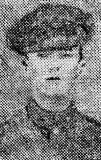
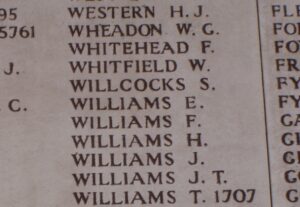
Evan Thomas, Private, 5197, Welsh Regiment. Evan was the son of William and Margaret Thomas, of Llwynheilog, Llanwrtyd Wells. He resided at Burry Port prior to the war but returned home to enlist at Llanwrtyd Wells into the Pembrokeshire Yeomanry. Evan was posted to Norfolk to join the 3/1st Battalion, Pembrokeshire Yeomanry, and was then posted to Dublin with the battalion. He saw service during the Easter Riots of 1916, before returning home on leave in July 1916. Evan embarked for France in August, where he was transferred to the 13th Battalion, Welsh Regiment, which was attached to 114 Brigade, 38th (Welsh) Division. The battalion was rebuilding following heavy losses at Mametz Wood in July. It then took over a section of the front at Hébuterne before moving to the Ypres Salient and taking over the Canal Bank sector at Boesinghe. The infantry battalions of the Division then began carrying out the normal pattern of rotation in the trenches, four days in the front, four in support and four in reserve, whilst also working on trench improvement, digging new trenches, and carrying out regular patrols and trench raids. On 5 September 1916 the 13th Welsh relieved the 11th SWB in the right sector of the Divisions new line, to begin a routine tour and began work on improving the trenches. Evan was wounded during this spell in the line and died of his wounds on 10 September 1916. The 24-year-old is buried in Ferme-Olivier Cemetery, Belgium. Evan is not commemorated at Burry Port.
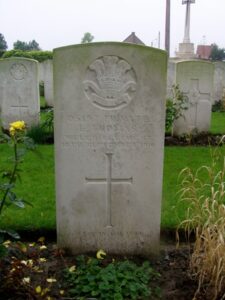
Gwyther Bartley Thomas, Private, 75091, Royal Welsh Fusiliers. Gwyther was the son of William Wyn Thomas and Elizabeth Thomas, of Pencoed Cottage, Burry Port. He enlisted at Carmarthen into the army and in 1918 was posted to France, joining the 9th Battalion, Royal Welsh Fusiliers, which was attached to 58 Brigade, 19th (Western) Division. In 1918 the division was caught up in the German Spring Offensive near St. Quentin, where they suffered terrible casualties, and fought at the Battle of Bapaume. They moved to Ypres, but were caught up in the German attack at Messines, and at Bailleul, and Kemmel. After suffering terribly again, they moved South to the quieter French sector to rebuild, but were caught up in the German offensive on the Aisne. Gwyther was wounded at some stage during the tumultuous periods of 1918, and was sent to Castle Street Hospital in Sherborne, Dorset for treatment. Gwyther died of wounds there on 29 October 1918, aged 19. He is buried at Pembrey (Hermon) Wesleyan Chapelyard.
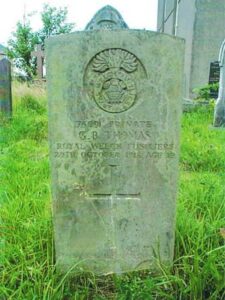
John Thomas, Private, 202060, Monmouthshire Regiment. John was the son of John and Margaret Thomas, of 23, Morton Terrace, Burry Port, and he enlisted at Carmarthen into the 2nd Battalion, Monmouthshire Regiment, which was the Pioneer Battalion to the 29th Division. The Division moved to Gallipoli via Egypt, landing on 25 April 1915. They remained here until evacuation to Egypt on 11 January 1916 and then moved to the Western Front on 15 March. The Division took part in its first major action in France during the 1916 Somme Offensive, and fought at the Battles of Albert and Le Transloy, suffering heavy casualties. In the spring of 1917 they fought at the Battle of the Scarpe, which was part of the Arras Offensive, and then moved further north to Ypres. Here they fought at the Battle of Langemarck, and then at the Battles of the Menin Road, Polygon Wood, Broodseinde and Poelcapelle, before moving to Cambrai. Here they fought at the Battle of Cambrai in November and December, 1917 before moving back to Flanders early in 1918. The German Spring Offensive hit the British on the Somme on 21 March 1918, and hit in Flanders just weeks later. John was killed in action in Flanders on 12 April 1918, aged 35. He has no known grave, and so is commemorated on the Ploegsteert Memorial, Belgium.

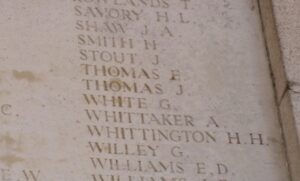
William Thomas, Lance Corporal, 7187, Northamptonshire Regiment. William was born at Merthyr, and enlisted at Northampton into the 7th Battalion, Northamptonshire Regiment. The Battalion was attached to 73 Brigade, 24th Division, and moved to France during August 1915, marching to positions near Loos, where they took up reserve positions for the main Battle of Loos. The inexperienced Division was sent into battle on 26 September 1915 at Loos and suffered terrible casualties. In 1916 they took part in the Battle of the Somme, and fought at Delville Wood and Guillemont, before moving north of Arras in early 1917. In April and May 1917 they fought at the Battle of Vimy, alongside the Canadian Corps, and in June they moved to positions south of Ypres, where they fought during the Battle of Messines. After the successful capture of Messines Ridge, the Division moved further north, and fought at the Battle of Pilckem, where William was killed on 31 July 1917. He has no known grave, and so is commemorated on the Ypres (Menin Gate) Memorial, Belgium. (The County war memorial roll shows this man as serving with the Northants, and this is the only Welshman of that name).
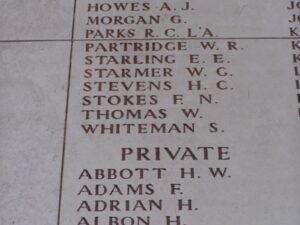
Martin Tierney, Private, 106, Leinster Regiment. Martin was the son of James and Johanna Tierney, of 3, East Cottages, Burry Port, and he enlisted at Maryborough into the 2nd Battalion, Leinster Regiment, attached to 17 Brigade, 24th Division. They moved to France during August 1915 and marched to positions near Loos, where they took up reserve positions for the main Battle of Loos. The inexperienced Division was sent into battle on 26 September 1915 at Loos and suffered terrible casualties. In 1916 they took part in the Battle of the Somme, and fought at Delville Wood and Guillemont, before moving north of Arras in early 1917. In April and May, 1917 they fought at the Battle of Vimy, alongside the Canadian Corps, and in June they moved to positions south of Ypres, where they fought during the Battle of Messines. Martin was killed in action here on 20 May 1916, and is buried at Ration Farm (La Plus Douve) Annexe, Belgium. Martin is not commemorated at Burry Port.
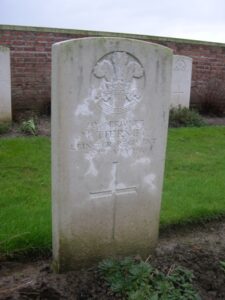
John David Vaughan, MC, Second Lieutenant, Welsh Regiment. John was the son of Henry and Rachel Vaughan, of 44, Mansel Street, Burry Port. He was educated at Aberystwyth University and served with the 14th Battalion, Welsh Regiment, which was attached to 114 Brigade, 38th (Welsh) Division. The Division had landed in France during December 1915 and had spent their first winter in the trenches near Armentieres. In June they marched south to the Somme, where they famously captured Mametz Wood. The Division suffered terrible casualties at Mametz, and were taken out of the line, and moved to Ypres to rebuild. John was wounded here, and sadly died of wounds on 18 March 1917, aged 30. He is buried at Ferme-Olivier Cemetery, Belgium. John had been awarded the Military Cross for ‘For conspicuous gallantry in action. He carried out a daring reconnaissance with great courage and determination, obtaining most valuable information.’ His award was gazetted on 9 January 1917.

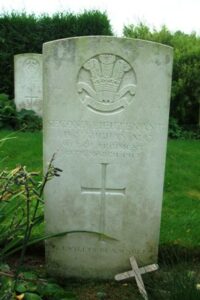
Herbert Wallis, Private, 86175, Machine Gun Corps. Herbert was born at Kilburn, Middlesex, and resided at Burry Port prior to the war. He enlisted at Carmarthen into the Welsh Regiment, and later transferred into the 204th Battalion, Machine Gun Corps, attached to the 66th (2nd East Lancs.) Division. The Division concentrated on the Western Front by 16 March 1917 and moved to the Flanders Coast. At the end of September 1917 they moved to Ypres, and took part in the Battle of Poelcapelle. They then moved south to the Somme, and on 21 March 1918 were hit by the German Spring Offensive at the Battle of St Quentin, and moving back west fought at the Actions at the Somme Crossings, and the Battle of Rosieres. After suffering very heavy casualties during the Battles of the Somme in 1918, the Division was first reduced to a training cadre and then reformed and reconstituted. During this period, many different units were attached for short periods. During this time, the Divisional artillery remained in action, and it did not rejoin the Division until 8 November 1918, by which time the Division had fought at the Battle of Cambrai, where Herbert was killed in action on 4 October 1918. He is buried at Le Cateau Military Cemetery, France. Herbert is not commemorated at Burry Port.
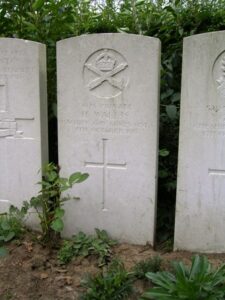
David James Williams, Private, 13385, Royal Welsh Fusiliers. David was born at Burry Port, the son of Isaac and Elizabeth Annie Williams. By 1911 the family had moved to 30, Rice Street, Llanelli. David enlisted there into the 9th Battalion, Royal Welsh Fusiliers, attached to 58 Brigade, 19th (Western) Division. The Division crossed to France during July 1915, and moved to positions near Loos. The Division fought during the opening attack of the Battle of Loos, and it was here that David was killed in action on 25 September 1915, aged 19. He has no known grave, and so is commemorated on the Loos Memorial, France. David is not commemorated at Burry Port.
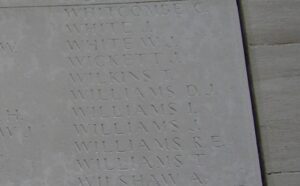
Edmund Williams, Sergeant, 15013, Welsh Regiment. Edmund was the son of Richard and Margaret Jane Williams, of 85, New Street, Burry Port, and enlisted at Pontlottyn into the 16th Battalion, Welsh Regiment. The Battalion was formed at Cardiff during August 1914 and became part of 115 Brigade, 38th (Welsh) Division. The Division had landed in France during December 1915 and had spent their first winter in the trenches near Armentieres. In June they marched south to the Somme, where they famously captured Mametz Wood. The Division suffered terrible casualties at Mametz, and were taken out of the line, and moved to Ypres to rebuild. Here they took part in the Battle of Pilckem Ridge on 31 July 1917, and this is where Edmund was killed in action on 1 August 1917 aged 23. He has no known grave and so is commemorated on the Ypres (Menin Gate) Memorial, Belgium.
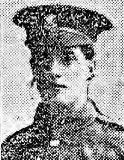
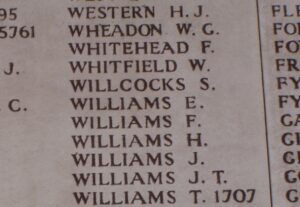
Herbert Llewellyn Williams, Sapper, 62352, Royal Engineers. Herbert was the son of Richard and Elizabeth Ann Williams, of Burry Port, and enlisted at Bristol into the 15th Signal Company, Royal Engineers. The company was attached to the 15th (Scottish) Division. During July 1915 the Division landed in France, where they were to win regard by the enemy as one of the most formidable in the British Army, and saw their first action at the Battle of Loos, where Herbert was wounded. He died of wounds on 3 October 1915, aged 33, and is buried at Mazingarbe Communal Cemetery, France.
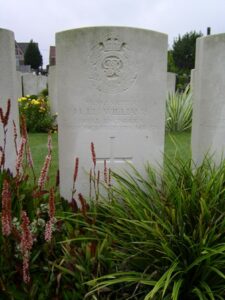
John Williams, Private, 38530, South Wales Borderers. John was born at Burry Port, the son of David and Margaret Williams. By 1911 the family had moved to 6, Nevill’s Terrace, Dafen. John enlisted at Llanelli into the 12th Battalion, South Wales Borderers, who were attached to 119 Brigade, 40th (Bantam) Division. This division was composed of bantam units, and moved to France during June 1916, and moved to the front near Loos. Late in 1916 they moved south to the Somme, and fought at the Battle of the Ancre, and remained in the area over the winter. In March 1917 the Germans withdrew to their shortened line, called the Hindenburg Line, and the Division was one of the Divisions that followed the withdrawal. Later in the year they took part in the Battle of Cambrai, playing an important role in the attack on Bourlon Wood. John was killed in action here on 25 November 1917, aged 18. He has no known grave, and so is commemorated on the Cambrai Memorial, Louverval, France. John is not commemorated at Burry Port.
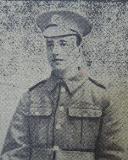
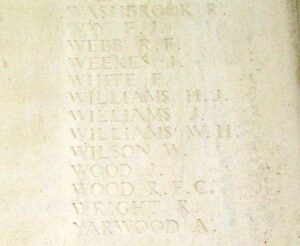
Thomas George Williams, Private, 125745, Machine Gun Corps (Infantry). Thomas was born at Burry Port, and enlisted at Llanelli into the Monmouth Regiment. He later transferred into the 21st Company, Machine Gun Corps, attached to the 30th Division. The Division moved to France in November 1915, and took part in its first major action during the Somme Offensive, at the Battle of Albert, where they captured Montauban. They then fought during the latter stages of the offensive, during the Battle of Le Transloy, before wintering on the Somme. In March 1917 the Division followed the German Retreat to the Hindenburg Line, and in April took part in the First Battle of the Scarpe, and then at the later Second Battle of the Scarpe. Later that year they were moved north to Ypres, and fought at the Battle of Pilckem. At the beginning of 1918 the Division were stationed near St. Quentin, and when the Germans launched their Offensive here on 21 March 1918, the Division took part in the Battle of St Quentin, but were pushed back, fighting at the Actions at the Somme Crossings, and the Battle of Rosieres. Thomas was killed at the Battle of St. Quentin on 24 March 1918, and is commemorated on the Pozières Memorial, France.
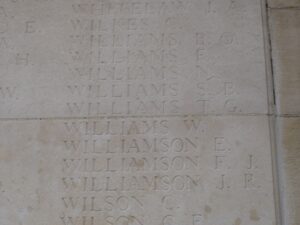
William Henry Winstone, Sergeant, 20248, Welsh Regiment. William was the son of Reuben and Miriam Winstone, of Bristol. He worked at Burry Port prior to the war and in 1912 married Agnes Davies, of 8, Park Terrace, Burry Port. William enlisted at Llanelli into the 15th Battalion, Welsh Regiment, which was the local Carmarthen Pals Battalion, attached to 114 Brigade, 38th (Welsh) Division. The Division had landed in France during December 1915 and had spent their first winter in the trenches near Armentieres. In June they marched south to the Somme, where they famously captured Mametz Wood. The Division suffered terrible casualties at Mametz, and were taken out of the line, and moved to Ypres to rebuild. Here they fought at the Battle of Pilckem Ridge, and this is where William was killed in action on 31 July 1917. He was 26 years old and is buried at New Irish Farm Cemetery, Belgium.
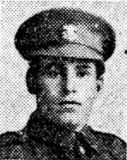
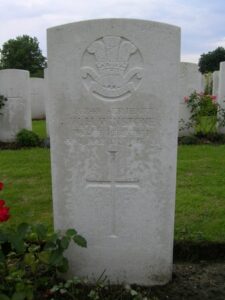
Frederick George Wotley, Private, 27966, Somerset Light Infantry. Frederick was the son of John Henry and Mary Jane Wotley, of 56, Richmond Street, Bristol. He resided at Burry Port prior to the war, where he worked for the Great Western Railway. Frederick joined the 7th Battalion, Somerset Light Infantry. The Battalion was attached to 61 Brigade, 20th (Light) Division. On 26 July 1915 the Division completed concentration in the Saint-Omer area, and moved to the Fleurbaix sector. When the Battle of Loos was launched on 25 September 1915 the Division fought a diversionary attack towards Fromelles. Later that year they moved north, and fought at the Battle of Mount Sorrel alongside the Canadian Corps. Over the winter of 1915/16, the Division remained in positions south of Ypres, and fought at the Battle of Mount Sorrel in June, alongside the Canadian Corps. They then fought through the Somme Offensive, at the Battles of Delville Wood, Guillemont, Flers-Courcelette, Morval and Le Transloy, and took part in the advance to the Hindenburg Line in March 1917. Later that year they fought at Third Ypres, where Frederick was killed in action on 7 August 1917, aged 24. He has no known grave, and so is commemorated on the Ypres (Menin Gate) Memorial, Belgium.
